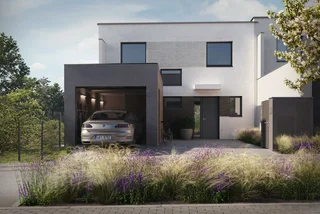The Prague district of Libeň has a rich architectural history, one that can be glimpsed in its mix of First Republic villas, once owned by famous families, working-class housing from the first half of the 20th century, and pleasant green spaces.
The district’s most famous resident was author Bohumil Hrabal, a fixture at local pubs, whose likeness can be seen on a mural not far from the Palmovka metro stop. The Libeň of Hrabal's era, however, is now evolving.
In recent years, the district has sprung to life, with public projects aimed at improving it streets, parks, and accessibility to transport. Many of its former industrial and spaces are being reclaimed by a new generation of residents who want to live near the city center but stay away from the crowds.
One new and notable development in this up-and-coming neighborhood wants to connect Libeň with its past while bringing it squarely into the future via environmentally sensitive construction with sustainable elements such as a grey water system that allows for the reuse of this precious commodity.
Devil's Hill
Čertův vršek, which translates to Devil's Hill, is not a very well-known spot in Libeň. There used to be a summer house with a large terrace facing south, but it has long been gone. Just the beautiful views of Prague have been preserved. The hilly nature of the site allows people to admire sunsets over the old villa houses lining the surrounding streets.
Skanska acquired the site and began construction in January 2020 on four buildings with with 39 large luxury apartments. The flats range up to 5+kk, with areas up to 177 square meters. The move-in date is set for spring 2022.
The architectural concept of Čertův vršek is intended to fit in with Libeň’s First Republic villas as these low-rise three-story apartment buildings that don’t overpower the surroundings. Selected apartments have high ceilings and lowered window sills for plenty of sun.

The project also includes several exclusive elements: the small size of the project, a community garden with modern trees, coded entrances to the house, and spacious layouts with protected private spaces both indoors and on terraces, balconies and front gardens.
Čertův vršek provides a modern, quiet and safe living in a residential area for people who like privacy but also want to live within reach of the center of Prague. Privacy and security are ensured thanks to the fencing around the area with an entrance gate and a camera security system.
Sustainable construction
Skanska, a subsidiary of Sweden’s Skanska AB, puts a premium on environmentally sensitive construction and sustainability.
The project also strives for international BREEAM certification, which saves not only the money of future residents due ot lower energy and water bills, but also protects the environment.

BREEAM, an acronym of Buildings Research Establishment Environmental Assessment Method, is an internationally recognized certification that assesses the building’s sustainable development from an environmental point of view as well as from a social and economic point of view.
“Skanska is a pioneer in the development of certified office buildings in the Czech Republic. We want to transfer sustainable construction to residential development,” Petr Michálek, CEO of Skanska residential development said. The company was the first to successfully certify a residential development project in the Czech Republic and will seek to do it again with the Čertův vršek project.
Saving water
Eva Neudertová, Specialist in Ecological Construction at Skanska, said Čertův vršek should have approximately 40% lower electricity bills and 30% lower water consumption after commissioning.
“So far, we are proud holders of a temporary BREEAM certificate at the Very Good level. Once the construction is completed, we expect to obtain a final certificate proving that the construction and operation of the Čertův vršek project are truly sustainable and environmentally friendly,” she said.

Saving on water usage is a key element for protecting the environment. The Czech Republic has been facing a long-term shortage of water, which is only expected to worsen in the future. The desire to save on water cuts across generational lines, as younger people are concerned with saving the environment for the future and older people are concerned with the rising costs of water.
Skanska was the first to address this issue by using a gray water management system in a residential development in the Czech market. They will continue on that success by using a similar system in the Čertův vršek project.
“Today, we are all aware of how scarce water is in our region and that it needs to be cared for and managed economically. If we want to look at the housing of the future from the point of view of its life cycle, we must look for new solutions to save energy and water, not just assume that the inhabitants of the house will be sufficiently aware and environmentally friendly,” Skanska CEO Michálek said.
This motivated Skanska to explore using gray water, a system that recycles and purifies water from bathtubs, showers and washbasins and uses it to flush toilets. If the gray water from these sources is not enough, the system will supplement it with captured rainwater or drinking water. Gray water helps to save up to 32% of drinking water consumption in apartment buildings.

This water recycling system is in addition to more efficient water fixtures, which have been standard in Skanska projects for some time. Rainwater around their developments is also collected and used.
Recycled concrete
A hidden impact that buildings have on the environment is in the use of concrete. The traditional production of concrete contributes to greenhouse gas. Debris from construction, which winds up in landfills. accounts for almost half of the waste in the Czech Republic. But concrete can be recycled, which cuts the CO2 footprint and waste impact of the new project.
Čertův vršek will be the first residential project in the Czech Republic to use recycled concrete. It will have Rebetong concrete, which has similar properties to the classic one. It is produced by rubble enriched with a nano admixture. The Czech patent is held by the companies ERC-Tech and Skanska.

“Rebetong has the potential to process most of the building debris that is generated in our country, and we specifically assume a utilization in the order of 70 to 80%. This would then represent about 20% of all concrete production,” Michálek said. The recycled material contains bricks, concrete, aggregates, mortars and plaster that can be separated when a building is demolished.
“This would save a huge amount of natural aggregate that could be used for applications where it is irreplaceable. At the same time, we can reduce the dumping of construction debris and thus reserve space in landfills for waste that cannot be recycled,” he added.
The concept is new, and still being expanded. Currently it is used only for base concrete, however, in the near future it should also be used for foundation slabs and perimeter masonry.

In total, about one-fifth of the concrete used in Čertův vršek will be recycled. Up to 900 m3 of concrete has been replaced with the same amount of Rebetong, using debris which would otherwise end up in landfills.
Savings in CO2 will include not only gases from production of new concrete but also reduced gases from transport. The recycled material does not have to be taken from the demolition site to landfills and the concrete plant does not have to import aggregate from the quarry to the concrete plant.
There will be further savings far in the future, since the materials can all be recycled again once the buildings are decommissioned.












 Reading time: 6 minutes
Reading time: 6 minutes 


















